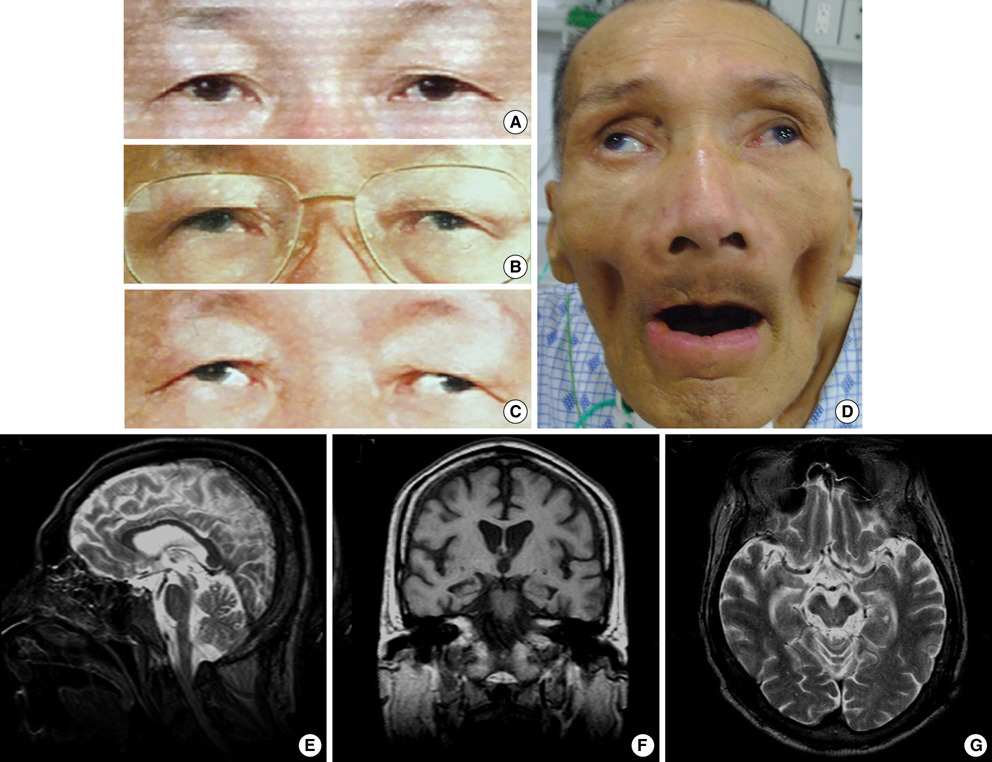J Korean Med Sci.
2009 Oct;24(5):982-984. 10.3346/jkms.2009.24.5.982.
Exodeviated Ophthalmoplegia in a Patient with Progressive Supranuclear Palsy
- Affiliations
-
- 1Department of Neurology, Han Family Hospital, Daegu, Korea.
- 2Department of Neurology, College of Medicine, Kyungpook National University, Daegu, Korea.
- 3Department of Neurology, College of Medicine, Yeungnam University, Daegu, Korea. mypark@med.yu.ac.kr
- KMID: 1782029
- DOI: http://doi.org/10.3346/jkms.2009.24.5.982
Abstract
- We report a patient with progressive supranuclear palsy (PSP) with his serial photographs before the onset of ocular symptoms and after the onset with two year intervals. These photographs show his progressive eyeball deviations toward complete exotropia. There were no effective voluntary eyeball movements, Bell's phenomenon, doll's eye movements, and vestibulo-ocular reflexes. These signs indicate the involvement of the oculomotor nuclear complex by the disease. We suggest that PSP may cause not only 'supranuclear' but also 'nuclear' complete ophthalmoplegia with exodeviation of the eyes.
MeSH Terms
Figure
Reference
-
1. Steele JC, Richardson JC, Olszewski J. Progressive supranuclear palsy: a heterogeneous degeneration involving the brainstem, basal ganglia, and cerebellum with vertical gaze and supranuclear palsy, nuchal dystonia and dementia. Arch Neurol. 1964. 10:333–359.2. Burn DJ, Lees AJ. Progressive supranuclear palsy: where are we now? Lancet Neurol. 2002. 1:359–369.
Article3. Flint AC, Williams O. Bilateral internuclear ophthalmoplegia in progressive supranuclear palsy with an overriding oculocephalic maneuver. Mov Disord. 2005. 20:1069–1071.
Article4. Morris HR, Wood NW, Lees AJ. Progressive supranuclear palsy (Steele-Richardson-Olzewski disease). Postgrad Med J. 1999. 75:579–584.5. Litvan I, Agid Y, Calne D, Campbell G, Dubois B, Duvoisin RC, Goetz CG, Golbe LI, Grafman J, Growdon JH, Hallett M, Jankovic J, Quinn NP, Tolosa E, Zee DS. Clinical research criteria for the diagnosis of progressive supranuclear palsy (Steele-Richardson-Olszewski syndrome): report of the NINDS-SPSP international workshop. Neurology. 1996. 47:1–9.6. Jellinger KA, Blancher C. Litvan I, Agid Y, editors. Neuropathology. Progressive supranuclear palsy: clinical and research approaches. 1992. Oxford: Oxford University Press;44–88.7. Hauw JJ, Daniel SE, Dickson D, Horoupian DS, Jellinger K, Lantos PL, McKee A, Tabaton M, Litvan I. Preliminary NINDS neuropathologic criteria for Steele-Richardson-Olszewski syndrome (progressive supranuclear palsy). Neurology. 1994. 44:2015–2019.
Article8. Rivaud-Péchoux S, Vidailhet M, Gallouedec G, Litvan I, Gaymard B, Pierrot-Deseilligny C. Longitudinal ocular motor study in corticobasal degeneration and progressive supranuclear palsy. Neurology. 2000. 54:1029–1032.
Article9. Troost BT, Daroff RB. The ocular motor defects in progressive supranuclear palsy. Ann Neurol. 1977. 2:397–403.
Article10. Mastaglia FL, Grainger KM. Internuclear ophthalmoplegia in progressive supranuclear palsy. J Neurol Sci. 1975. 25:303–308.
Article11. Zee DS. Internuclear ophthalmoplegia: pathophysiology and diagnosis. Baillieres Clin Neurol. 1992. 1:455–470.
- Full Text Links
- Actions
-
Cited
- CITED
-
- Close
- Share
- Similar articles
-
- WEBINO (Walleyed Bilateral Internuclear Ophthalmoplegia) Syndrome in Progressive Supranuclear Palsy
- A Case Report of Progressive Supranuclear Palsy (Steele-Richardson-Olszewski Syndrome)
- Probable Creutzfeldt-Jakob Disease Presenting as Progressive Supranuclear Palsy
- Progressive Supranuclear Palsy Presenting as Primary Progressive Aphasia
- Cretzfeldt-Jakob Disease Mimicking Progressive Supranuclear Palsy Presenting With Supranuclear Gaze Palsy and Early Falling


